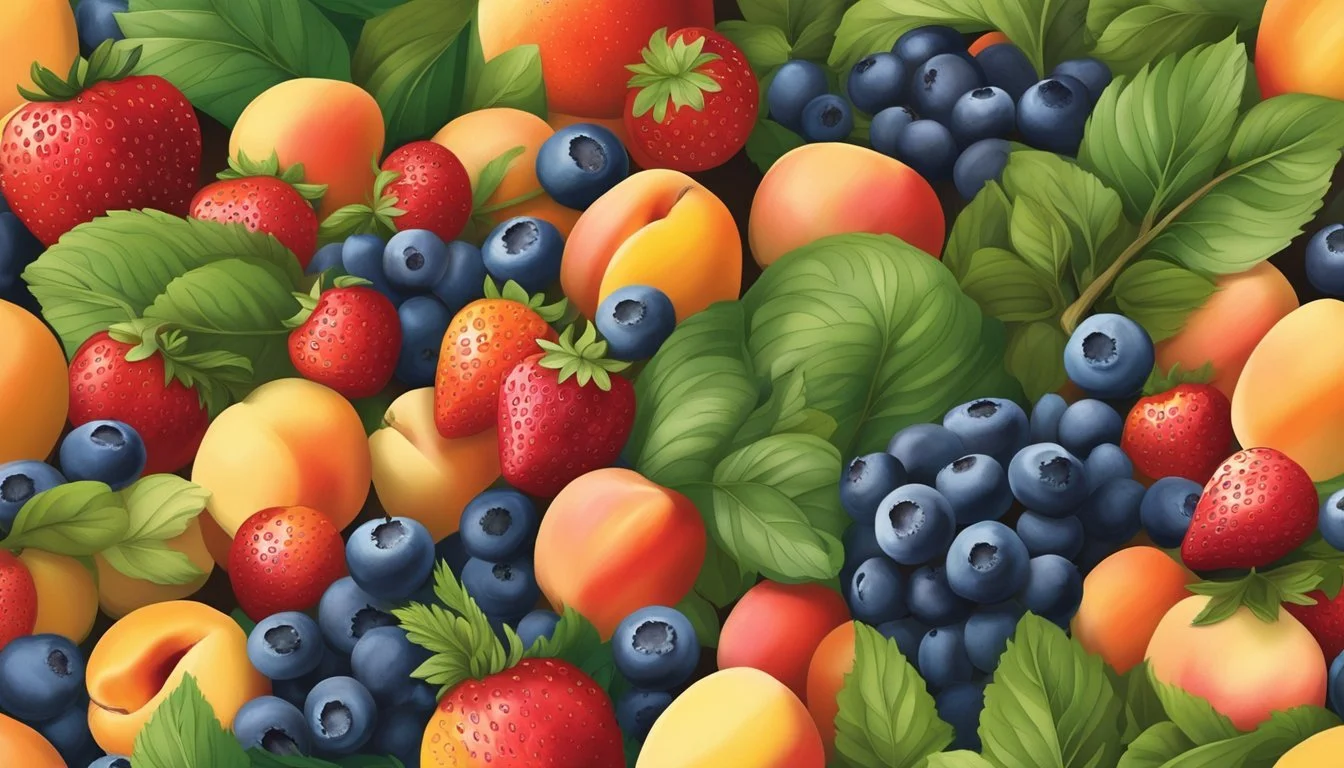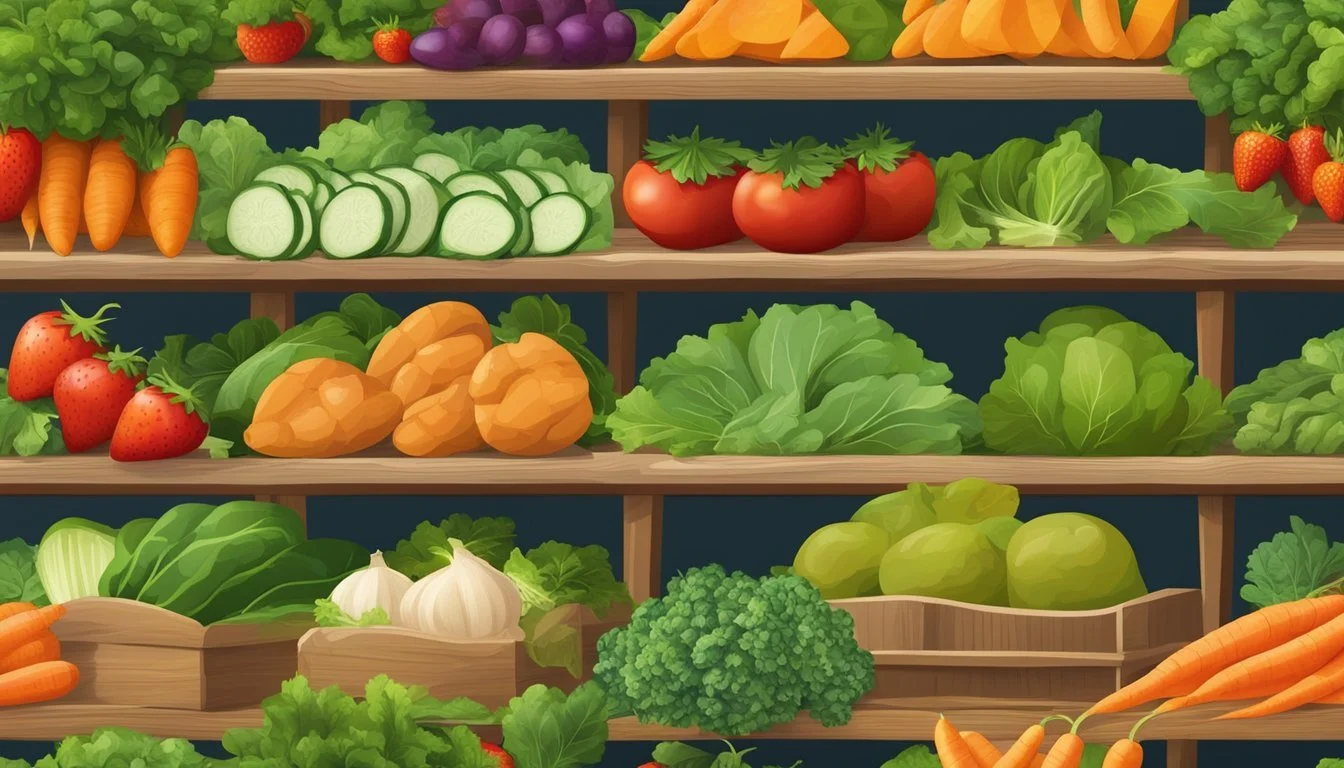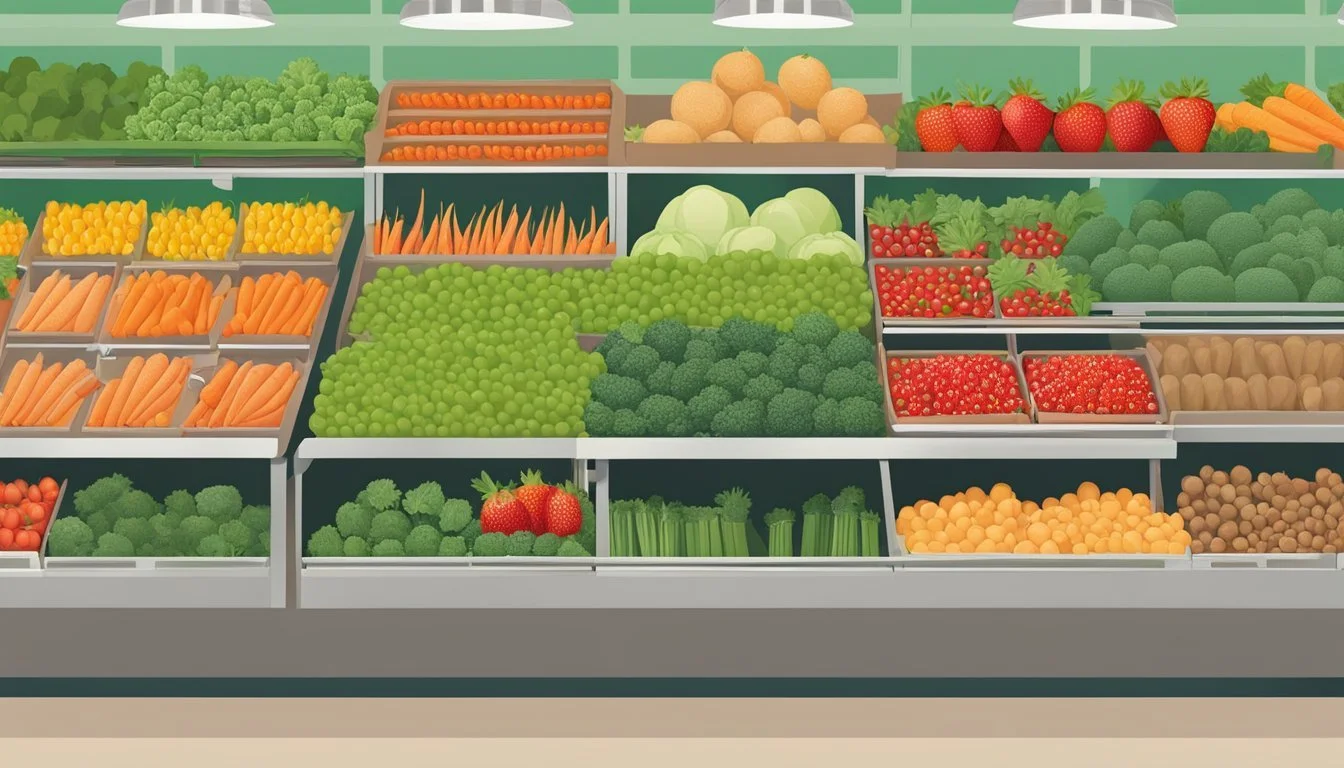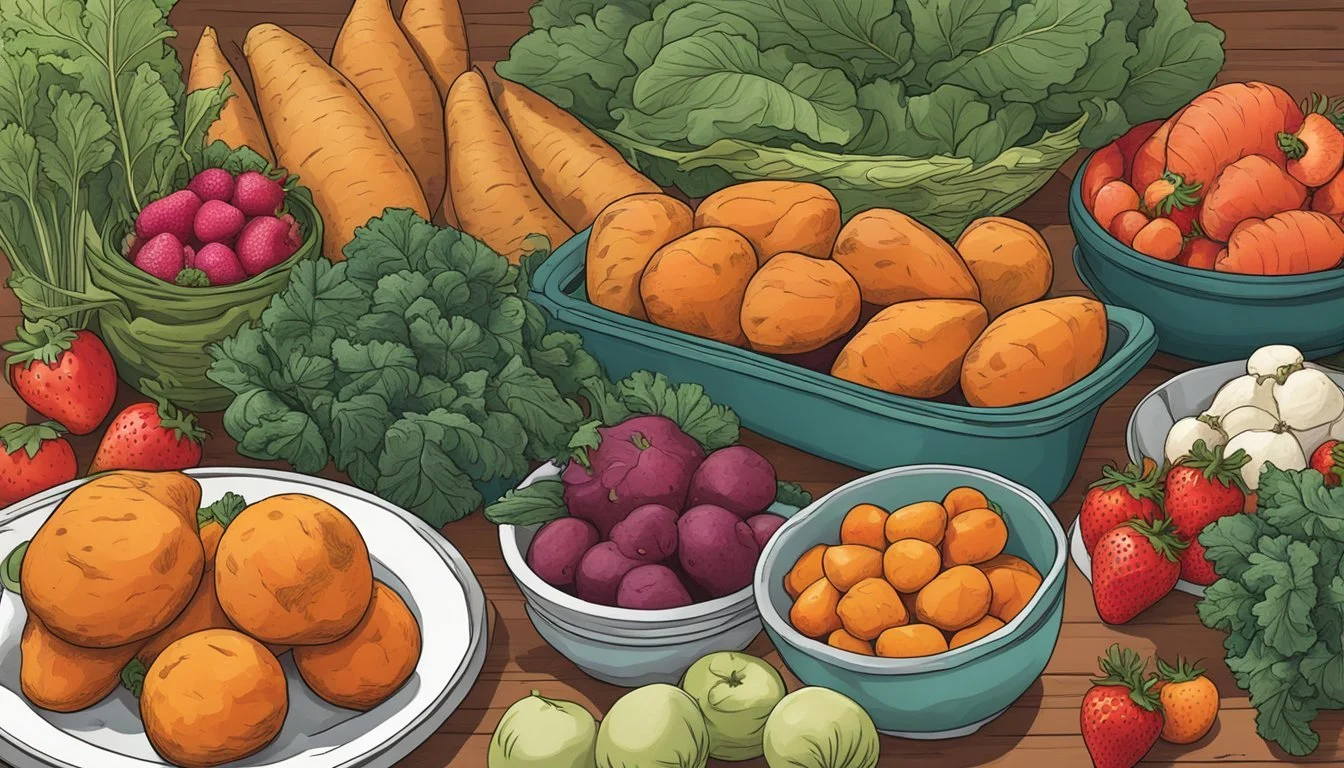South Carolina Seasonal Fruit & Vegetables in February
A Guide to Winter Produce Selection
This Article is Part of our South Carolina Seasonal Fruit & Veg Calendar
In South Carolina, February marks a period where the chill of winter begins to mingle with the subtle hints of spring's approach. This transitional month influences agricultural patterns, allowing for the growth of a spectrum of fruits and vegetables that can withstand the cool yet gradually warming climate. South Carolina’s mild winters, characterized by their own unique set of growing conditions, shape a seasonally distinct selection of produce.
The state sees a variety of citrus fruits reaching their peak during February; this includes an abundance of lemons, limes, oranges, and grapefruits. The cooler months are particularly favorable for citrus, and these fruits become a common find, bringing vibrant colors and flavors to local markets. Additionally, the season extends to some other fruits such as kumquats and select hybrid varieties like Sumo Citrus.
Vegetables suited to cooler temperatures also thrive during this time. Gardeners and farmers in South Carolina take advantage of the season by planting and harvesting vegetables that can withstand or even prefer February's climate nuances. Root vegetables and leafy greens are typically hardy in the face of colder nights, while the lengthening days encourage the growth of certain varieties that will continue to mature as the state heads toward spring.
Seasonal Overview
South Carolina's mild climate allows for an extensive growing season, providing a bounty of fresh produce even during the winter months. The state enjoys year-round harvesting with some variation due to annual weather patterns.
Winter Produce in South Carolina
Fruits: The cooler months in South Carolina do not stop the state from offering a vibrant selection of fruits. Citrus fruits, such as lemons, limes, oranges, and grapefruits, are particularly flavorful and abundant during February. Other winter fruits include:
Apples
Blood oranges
Clementines
Kiwi
Vegetables: Vegetable crops thriving in February's chill include:
Mustard greens
Turnips
These vegetables are more than mere seasonal staples; they are a testament to South Carolina's rich agricultural tapestry, which perseveres even in cooler temperatures.
Crop Availability and Harvest Times
Each year may bring variations to harvest times, but February typically sees the following produce at its peak:
Fruit Harvest:
Citrus: Lemons, limes, and oranges
Vegetable Harvest:
Leafy Greens: Collards, mustard greens
Root Vegetables: Turnips
Farmers in South Carolina adapt to the winter month with crop selections that can withstand the cold, ensuring regular crop availability of hearty vegetables and resilient fruits.
Fruits in Season
February in South Carolina is especially conducive for enjoying a variety of fresh fruits, predominantly citrus varieties, with tree fruits and berries also offering limited options. This region's mild climate supports winter fruit production, providing consumers with both flavor and nutrition during the colder months.
Citrus Varieties
Citrus fruits are a vibrant highlight of the season, with their peak ripeness occurring in February. Consumers can expect:
Blood oranges: Recognizable for their deep red flesh, offering a distinctive rich taste compared to their regular counterparts.
Lemons: Essential for their zest and juice, they are kitchen staples for both sweet and savory dishes.
Grapefruit: These come in several varieties, ranging from the classic pink to ruby red, celebrated for their tangy yet semi-sweet flavors.
One should also not overlook the availability of common oranges and tangerines, which provide not only a refreshing snack but also a boost of vitamin C during cooler weather.
Tree Fruits
While the selection is more limited compared to citrus, certain tree fruits are still prominent:
Apples: They continue to be available from fall's harvest, retaining their crisp and juicy characteristics.
Pears: These may also be found and are cherished for their sweet, buttery flesh.
These fruits are versatile for both eating raw or as ingredients in warming winter recipes.
Berries
Berries are generally not in peak season during February in South Carolina; however, there can be some greenhouse-grown varieties available. It is more common to find these fruits as preserved goods, such as jams and jellies, during this time. Fresh berries are typically expected in the approaching spring months.
Vegetables in Season
South Carolina's February harvest brings a variety of fresh vegetables to the table. Root vegetables, cruciferous vegetables, and leafy greens are especially abundant this time of year, offering not only robust flavors but also nutritious benefits.
Root Vegetables
South Carolina's fertile soil yields several root vegetables during February. Consumers can find:
Onions: A versatile vegetable found in multiple varieties, suitable for both raw and cooked dishes.
Potatoes: Starchy and hearty, perfect for a wide range of culinary uses from baking to mashing.
Turnips: Offering a slightly peppery flavor, great for roasting or in stews.
These root vegetables can be stored in a cool, dark place to maintain freshness.
Cruciferous Vegetables
The mild winter climate allows for the growth of various cruciferous vegetables:
Cabbage: Known for its crisp texture, it can be used in slaws or cooked dishes.
Broccoli: A staple in the American diet, ideal for steaming, stir-fries, or raw snacks.
Collard Greens (how long do collard greens last?): A southern classic, often slow-cooked for a traditional side dish.
They are not only flavorful but also packed with vitamins and minerals.
Leafy Greens
Leafy greens thrive in the cooler weather of February in South Carolina:
Kale: This nutrient-dense green can be used in salads, smoothies, or chips.
Lettuce: Available in many varieties, it serves as the base for salads and other cold preparations.
Peas: While often associated with legumes, some types like snow peas are enjoyed for their crisp pods and tender leaves.
Leafy greens are best when used fresh and can be incorporated into a variety of dishes for added nutrition.
Herbs and Other Produce
In February, South Carolinians can enjoy a variety of herbs and produce suited to the region’s mild winter climate.
Herbs: February is not the peak season for a wide range of herbs, but basil (how long does basil last?) stands out due to its adaptability. Basil, though traditionally grown from May through September, may be cultivated indoors or in controlled environments to add freshness to dishes during winter.
Mushrooms: While mushrooms can be foraged year-round, February's cooler, damp conditions can be suitable for growing certain varieties. South Carolina's woodlands may yield wild mushrooms, but one should only forage with expert guidance to avoid toxic species. Alternatively, cultivated varieties like white button, cremini, and shiitake mushrooms are commonly available in markets.
Below is a table summarizing available herbs and other produce in South Carolina during February.
Produce Type Items Available Notable Information Herbs Basil (limited) Indoor or controlled environment cultivation Mushrooms Varied (location-dependent) Forage with caution; availability depends on conditions
When cooking with herbs in February, they advise chefs and home cooks to source from reputable grocers or indoor gardens. Mushrooms, given their nature, should always be selected with care due to the risks associated with misidentification. With these guidelines in mind, February can still yield a modest but flavorful selection of herbs and other produce to enrich culinary endeavors in South Carolina.
Market Availability
In South Carolina during February, consumers have access to a range of fresh produce predominantly from local markets and grocery stores, comprising seasonal items ideal for side dishes, salads, and soups.
Farmers' Markets
At South Carolina farmers' markets, one would find a vibrant assortment of seasonal produce directly from local farmers. These markets typically offer a wide variety of fruits and vegetables, including collard greens, kale, and mustard greens, which are in full swing this time of year. Shoppers can often discover root vegetables like turnips and rutabagas, perfect for hearty recipes. Many markets also host vendors selling fresh cut flowers and herbs, adding a gourmet touch to home-cooked meals.
Notable Farmers' Markets in South Carolina:
Columbia State Farmers Market
Charleston Farmers Market
Greenville State Farmers Market
Grocery Stores
Grocery stores across the state are stocked with both local and imported produce to ensure a diverse selection. South Carolina's grocery stores ensure a continuous supply of fresh fruits and vegetables year-round. Customers can find staples such as beets (how long do beets last?), cabbage, and carrots, alongside seasonal specialties for a complete culinary experience.
Seasonal Produce at Grocery Stores:
Vegetables: Beets, Cabbage, Cauliflower, Onions
Fruits: Citrus Fruits (limited selections), Avocados
Greens: Kale, Turnip Greens, Mixed Leafy Greens
The collaboration between the SC Dept. of Agriculture and USDA-AMS Fruit & Vegetable Division plays a pivotal role in monitoring and ensuring the quality and availability of produce in markets throughout the state.
Preparing and Storing Seasonal Produce
When handling seasonal produce such as fresh fruits and vegetables available in South Carolina during February, it is crucial to ensure they retain their flavor and nutritional value. Each type of produce requires different methods for preparation and storage. Here are some guidelines:
Washing: To maintain the integrity of fresh fruits and vegetables, one should wash them thoroughly under running water to remove any dirt or contaminants. This step should be done right before consumption or cooking to prevent premature spoilage.
Salads: Ingredients for salads, such as leafy greens, should be dried well after washing to maintain crispness. They can be stored in the refrigerator wrapped in paper towels to absorb excess moisture.
Soups and side dishes: For vegetables destined for soups or as side dishes, cutting them uniformly ensures even cooking. These can often be stored in airtight containers in the refrigerator until ready to cook.
Fruits: Citrus and apples, common February fruits, do not require refrigeration, but it helps to prolong freshness. Berries, on the other hand, should be refrigerated and kept in their original packaging or a covered container.
Storage life: Here’s a quick reference table for some February produce:
Produce Refrigerate Room Temperature Notes Apples Optional 1-2 weeks Refrigerate for longevity Citrus Optional 1 week Refrigerate for longevity Leafy Greens Yes N/A Use within 1 week Berries Yes N/A Consume within days
Preservation: For long-term storage, one can consider canning, freezing, or drying. However, these processes require proper techniques to maintain the safety and quality of the food.
One should always keep peeled or cut produce in the refrigerator to minimize the risk of foodborne illnesses and to prolong shelf life. For those looking to prepare recipes in advance, consider the natural storage life of your ingredients to ensure the best quality of your meals.
Health Benefits and Nutrition
In February, South Carolina's seasonal produce offers a rich array of health benefits and nutritional value. Fresh fruits and vegetables such as grapefruits and spinach not only lend vibrant flavors to the winter plate but also contribute significantly to one's overall well-being.
Grapefruits, an immune-boosting citrus fruit, are abundant and provide a wealth of vitamin C which is crucial for immune system function. They also contain fiber, antioxidants, and other vitamins that can help maintain a healthy heart.
Spinach, a verdant leafy green, is another February staple in South Carolina. It is high in vitamins A, C, and K1, as well as iron and calcium. Spinach supports vision health, bone strength, and has anti-inflammatory properties.
Seasonal Vegetable Key Nutrients Health Benefits Spinach Vitamins A, C, K1, Iron, Calcium Improves vision, bone strength, reduces inflammation Grapefruit Vitamin C, Antioxidants, Fiber Boosts immunity, supports heart health
Consuming fresh fruits and greens introduces a variety of nutrients into one's diet, which can reduce the risk of chronic illnesses and aid in maintaining a balanced diet. Including seasonal vegetables and fresh fruit from South Carolina ensures produce is at peak freshness and nutritional value, maximizing the health benefits available to consumers.
Support Local Agriculture
South Carolina's local markets are bastions of community support and sustainability. They provide an essential platform where farmers can connect directly with consumers. The state's farmers' markets are not just points of sale but are integral components of the local economy and cultural heritage.
Purchasing produce at these markets ensures that money spent on fruits and vegetables stays within South Carolina, bolstering the local economic cycle. This symbiotic relationship aids in preserving farming livelihoods and contributes to the diversity of crops grown regionally. Moreover, buying locally reduces the carbon footprint associated with long-distance transportation of produce.
Farmer's Markets in South Carolina:
Enhance community bonds
Support local farmers financially
Promote sustainable farming practices
Provide fresh, seasonal produce to consumers
Fruits and Vegetables in Season (February):
Collards
Mustard Greens
Turnips
Benefits of Shopping at Local Markets:
Freshness: Locally sourced produce is typically fresher than that found in supermarkets, having been harvested at peak ripeness.
Nutrition: Fresh fruits and vegetables retain more nutrients, as they spend less time in transit from farm to table.
Economy: Money spent locally stimulates the South Carolina economy, supporting farmers and creating jobs.
Environment: Reduced transportation distances mean a smaller carbon footprint and less environmental impact.
In embracing farmers' markets, the community demonstrates its dedication not only to the health of the local economy but also to the sustainability of South Carolina's bountiful agriculture.
Culinary Uses and Recipes
In February, South Carolina offers a bounty of seasonal produce that lends itself to delicious recipes and culinary exploration. Citrus fruits, such as lemons, limes, and oranges, are at their peak, presenting an opportunity for zesty and fresh dishes.
Citrus Fruit Citrus fruits can add a refreshing twist to any dish. They can be used in:
Salad dressings: A simple vinaigrette with lemon or lime juice, olive oil, salt, and a hint of honey.
Desserts: Orange zest-infused chocolate cake or lemon meringue pie.
Marinades: Lime juice and zest can tenderize and add flavor to chicken or fish.
Winter Vegetables Seasonal vegetables like beets can be creatively integrated into meals:
Roasted Beets: An earthy side dish that pairs well with herbed goat cheese.
Beet Salads: Sliced beets with a balsamic reduction, walnuts (how long do walnuts last?), and arugula.
Herbs, like rosemary and thyme, still thrive in cool February temperatures and can enhance the flavor profiles of both fruit and vegetable dishes.
Culinary Pairings These seasonal ingredients can be paired in various ways. A vibrant dish might include:
A beet and citrus salad with a sprig of thyme.
Herb-roasted root vegetables as a hearty side dish.
Fresh Fruit Utilizing fresh fruit as a base for sauces or garnishes adds not only flavor but also visual appeal to any plate. A chef might drizzle a citrus glaze over roasted pork or garnish a dessert with thinly sliced oranges.
In conclusion, the use of seasonal produce from South Carolina in February encourages culinary creativity and maximizes the flavors in an array of recipes.
Looking Forward
As February marks the end of winter in South Carolina, gardeners and farmers anticipate the transition to warmer weather and the start of the spring harvest season.
Transitioning into Spring
During the latter part of February, South Carolina's agricultural focus slowly shifts towards planting and preparing for the crops of spring and early summer months. Asparagus, a perennial favorite, begins to emerge, with its tender shoots signaling the onset of a new growing cycle. Farmers often start to sow beans indoors, as these crops require warmer soil temperatures that are consistent with South Carolina's spring climate.
Strawberries also become a point of interest, as February serves as a crucial time for tending to strawberry plants that will soon yield their fruit as spring progresses. These berries thrive in the mild South Carolina spring, and meticulous care in February can set the stage for a plentiful harvest.
While winter crops like collards and turnips are still abundant in February, the planning and groundwork laid during this month are essential for a productive transition into the bountiful spring and summer months.












